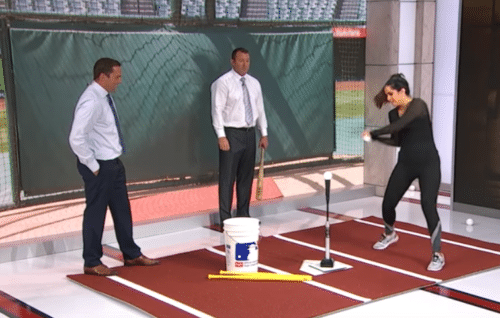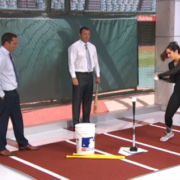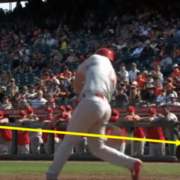Leg Kicks May Be Dangerous To Pitchers (And Hitters That Don’t Perfect Them)…
Before I get into the Rhys Hoskins swing breakdown video featuring Mark DeRosa & Cliff Floyd above…
I wanted to give you a heads up of what’s in this post:
- Lesson learned from my school of hard knocks,
- How to fix striking out every at-bat in tournament, and
- Rhys Hoskins swing breakdown.
Lessons Learned from School of Hard Knocks

Rhys Hoskins says his thought is “down to the ball”, then adds, “obviously you’re not swinging down like you’re chopping wood.” He’s hoping that thought process will keep him on a level plane in the strike-zone as long as he can. Photo courtesy: Sports Bay Area
I recently worked with a newer 12/13u hitter of mine, where he shared he had a terrible tournament, where he struck out virtually every at-bat the weekend before.
This immediately raised a red flag for me.
The easy thing to do for a player – and a dad or mom – is to point to a breakdown in hitting mechanics.
As a hitting coach, if this isn’t your first rodeo, then you know this is not the case a majority of the time.
Quick back story,
My last year of Little League was insane:
- Hit .880 regular season, .770 in All-Stars,
- 30+ dingers,
- 40+ doubles, and
- Struck out a grand total of 3 times in the span of 6 months.
By the way, looking at old VHS video of that swing, I was doing what I teach now. All those strikeouts were early in the regular season, and once I settled down, they vanished entirely.
I was ignorance on fire!
Brace yourself for the “fall”…
The next year I made the move to the big field, with no pitching distance transition like there are nowadays. I found myself swinging and missing A LOT.
I got so frustrated with myself, and what do you think my dumb brain thought was the problem?
Right-O!! Mechanics.
Do you know the REAL cause?
Let me give you a clue…the word starts with a “T” and ends with “-iming” 😛 lol
I was being driven by my fear of getting “caught up” to by other players. And yes, the whispers started in Middle School when I struggled to recover my old swing.
Do you know how much of a nightmare that is for a hitter who’s super driven to succeed like I was?
This fear drove me into the bookstore to read every book on hitting I could get my hungry teenager hands on. Ted Williams, Tony Gwynn, Charlie Lau, Mike Schmidt, and on and on. Nothing seemed to help. I obsessively watched film of that swing trying to figure out what I was missing or leaving out.
Hey, at least I wasn’t out stealing cars!
It was a 4-year mind-fudge that ended in recovering my batting average – somewhat – but not my power the last two years in High School. Thinking back now, it’s a miracle I ended up with a scholarship at Fresno State.
The point of this story is, negative tournament outcomes don’t necessarily mean a breakdown in hitting mechanics.
Back to my young hitter…
How To Fix Striking Out Every At-Bat in Tournament
So I had three questions I planned asking my hitter, in diagnosing the challenges he had with his last tournament:
- The first one is, were you focusing on the new stuff we worked on last lesson (which was a week before), during game at-bats?
- If the answer is NO to that question, then I would ask, how many strikes did you swing at, OR not swing at?
- If they’re swinging at good pitches, then on the swings you took, how many were “on-time”?
If they pass the first three questions, then we look at seeking and fixing the ineffective swing mechanic.
However, this particular hitter failed question one. I hadn’t warned him about bringing new swing techniques into game at-bats. I told him that in games, your focus MUST be on swinging at good pitches and getting on-time. It’s to compete.
I teach hitters my painful lesson.
The good news is, this hitter will be on the up and up again, and won’t have to go through the frustration, struggle, and anger I went through attempting to fix something I knew nothing about at the time. And frankly, the only one who had a clue was Ted Williams, but his message was drowned out in the other white noise I was hearing, reading, and watching. Paralysis by over analysis.
Now, let’s tie in the Rhys Hoskins video above…
Grab This FREE 'Timing Master Class' Video
Struggling to get your hitters ON-TIME in games? Discover HOW TO build effective laser-focused timing, so your hitters can be ON-TIME more often. These principles are validated by REAL science.
Click the button below to access the FREE video that has been downloaded over 6K times!
Click here to 'Get Instant Access'
Rhys Hoskins Swing Breakdown
Below you’ll find video notes I took. Afterward, I’ll only focus on about a couple of these, I think others will make for good conversation in the Comments section below…
- About 1:20 min mark, DeRosa: “Hands go along for the ride…not a lot of hand load”
- About 1:40 min mark, DeRosa brings up examples of “violent hand loads” featuring: Cecil Fielder, Vlad Guerrero, Gary Sheffield…and Manny Ramirez, Buster Posey, Justin Turner, and Daniel Murphy used as examples of “not a lot of hand load”
- About 2:20 min mark, DeRosa: asks Rhys is he’s conscious about his pre-swing hand movement. Rhys says all he’s worrying about is having some separation between his body and where his hands are during load
- About 2:50 min mark, Rhys: “The only thing I’m thinking about is getting my leg up”. Cliff Floyd talks about having a leg kick is a perfection type of approach. Pitchers are trying to disrupt a leg kicker: tempo, changing speeds, etc.
- About 3:20 min mark, Floyd says Rhys has something you can’t teach: “He hits the fast-ball, he hits the curve-ball, he hits the change-up”…Floyd says it’s going to be tough to get him out when he covers the plate well and doesn’t like to strikeout.
- About 4:00 min mark, Cliff Floyd goes into more detail about a hitter focusing on perfecting the timing of a leg kick, and not worry about anything else, or else you’re screwed. Rhys talks about getting “inside the pitcher’s rhythm in the on-deck circle”. Cliff Floyd comments: “Did I pay attention to what that pitcher really does consistently” with his timing and rhythm in the on-deck circle.
- About 5:10 min mark, Mark DeRosa is wanting Rhys to explain the use of his hands and back elbow. Cliff Floyd says if you want the kid to go into a slump keep talking about hands and elbows. Rhys says his thought is “down to the ball”, then adds, “obviously you’re not swinging down like you’re chopping wood.” He’s hoping that thought process will keep him on a level plane in the strike-zone as long as he can.
- About 6:10 min mark, talks about “knee to knee” “hover” leg kick. More balance, don’t get over backside.
A lot more good than bad in this video. I wanted to focus on the timing aspect though…
Just to be upfront with you, I’m not one of those instructors that teaches a leg kick to ALL my hitters. I think this is a BIG mistake. If my hitter doesn’t have what I call a “Float” (aka stride type) built into their swing already, then I ask them to experiment a little. Or if what they’re using isn’t effective at getting them on time and dynamically balanced, then we get resourceful.
We experiment with:
- A leg kick (medium or high),
- Slide step, and
- Toe-tap.
By the end, they find that one of these techniques allows them to time the ball better, and it may not be what they started with. We’re looking for what they’re comfortable with, and can execute the swing dynamically balanced.
You heard Rhys Hoskins say,
“The only thing I’m thinking about is getting my leg up”
This was after DeRo prodded him to explain what his hands and back elbow are doing. Cliff Floyd got on DeRo that he’s going to force Rhys into a slump with all this hands talk! lol
Floyd also said that a lot of time and energy needs to be spent on perfecting the timing of the leg kick. He added, “Did I pay attention to what that pitcher really does consistently” with his timing and rhythm in the on-deck circle. This is very important.
Some of my good hitting friends online, who I highly respect in their knowledge, don’t believe timing can be taught or calibrated. I respectfully disagree.
If you can teach a pair of chickens to play ping-pong, then yes, timing can be taught. True story by the way – with the chicken (read Don’t Shoot The Dog: The New Art Of Teaching And Training ).
).
I’ve also heard pitching coaches on the Socials say they lick their lips when seeing a hitter with a leg kick. And you heard Cliff Floyd address a pitcher’s job is to disrupt a leg kicker by changing their delivery tempo, changing speeds, etc.
But then Floyd turns around and compliments Hoskins saying, “He hits the fast-ball, he hits the curve-ball, he hits the change-up”…and adds, it’s going to be tough to get him out when he covers the plate well and doesn’t like to strikeout.
Calibrating a hitter’s timing and pitch recognition training are a deadly combination for pitchers who salivate over seeing a leg kicking hitter. I asked this coach whether he’d salivate over facing Josh Donaldson, Justin Turner, or Mike Trout. He didn’t answer.
Coaches, if you don’t give hitters tools for their toolbox, then they’re up there hitting blind. Don’t make them hit the pinata blind folded!
Here are some resources to take back to your hitters on timing and pitch recognition:
You can teach timing. You can teach pitch recognition. Woe to the pitcher that pitches to hitters who train both. The winds of change are a blowin’ for hitters over pitchers. When troubleshooting with your hitters, remember:
- The lesson from my school of hard knocks,
- How to fix striking out every at-bat in a tournament, and
- Timing lessons from Rhys Hoskins.
Grab This FREE 'Timing Master Class' Video
Struggling to get your hitters ON-TIME in games? Discover HOW TO build effective laser-focused timing, so your hitters can be ON-TIME more often. These principles are validated by REAL science.
Click the button below to access the FREE video that has been downloaded over 6K times!
Click here to 'Get Instant Access'

that goes more into this. Sorry, only paperback version available on Amazon.
, that in order to hit .300, hitters MUST be able to lift the low pitch AND hit the ball to the opposite field.






